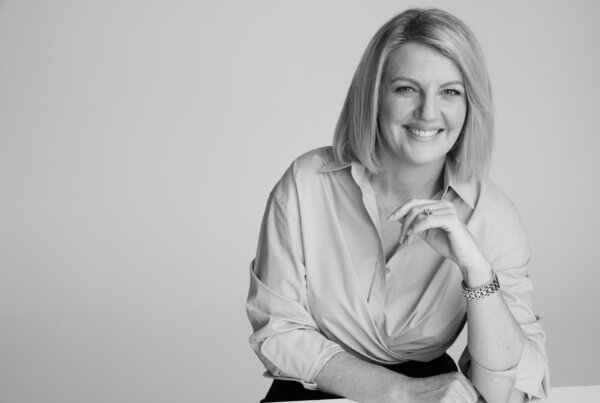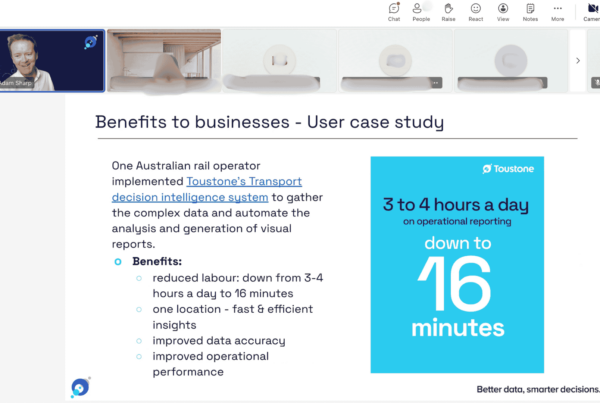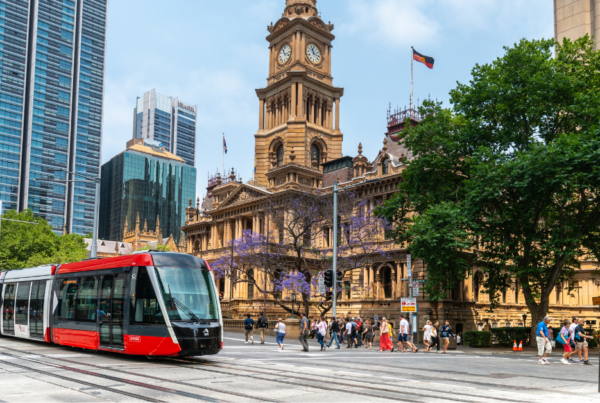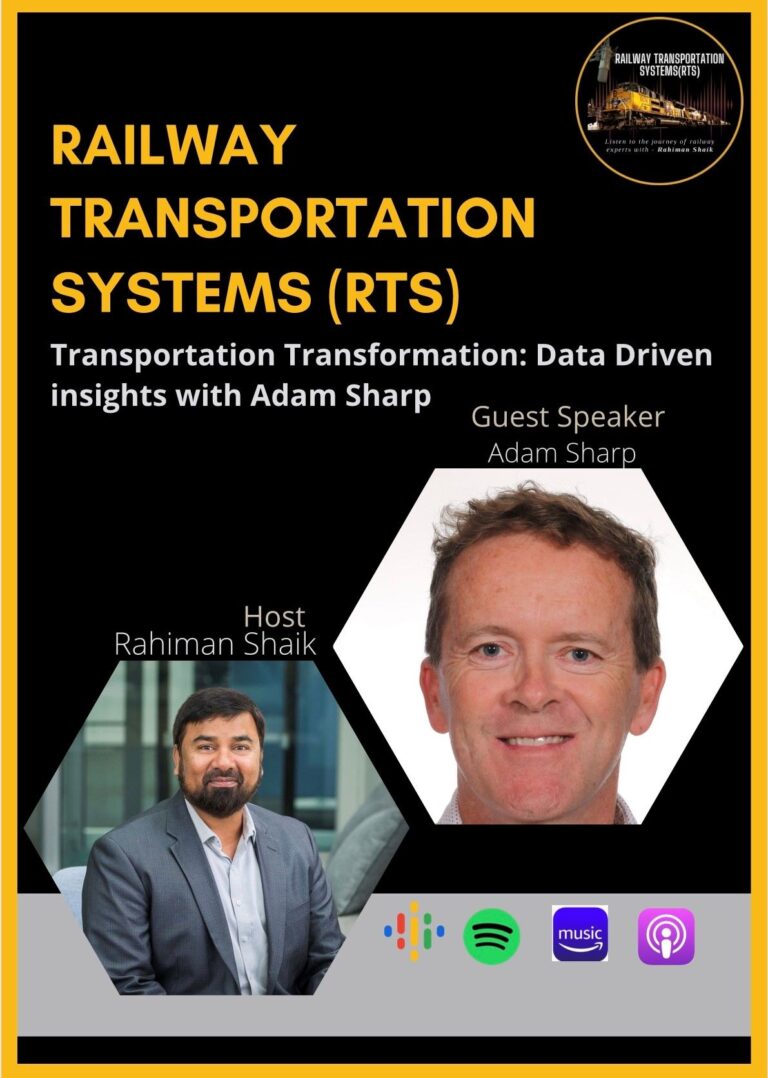
Interview on the Railway Transportation Systems Podcast
Co-Founder of Toustone and Services Delivery Director, Adam Sharp, was recently invited to the Transportation Systems Podcast to discuss his decision intelligence expertise and long-standing experience in spearheading data solutions for the transportation and logistics industry.
Adam has overseen the delivery of decision intelligence solutions across the Asia-Pacific and Europe for decades, and excels in working with top executives to develop diverse solutions. These solutions allow transport leaders to make powerful proactive decisions, seize opportunities and mitigate risk effectively.
In this interview, Adam explains how Toustone is at the forefront of using machine learning to forecast transport operational outcomes accurately, exciting new technological developments for transport and his experience working cross-culturally on transformative projects in his career.
Host Rahiman Shaik, railway systems specialist and Associate Director of Rail Systems for Sydney Metro, has managed industry projects around the world with a career in transportation spanning over 26 years. With a background of mentoring and training technical engineers, his podcast features interviews with global railway industry leaders to bring education and motivation to those in the transport industry, celebrating a fast-paced and ever-developing space.
1. You are known to use the term ‘Decision Intelligence’ instead of ‘Business Intelligence’. Can you describe the difference between these two?
Adam: Well, that’s a great place to start. The two terms are often used interchangeably, but from our perspective, business intelligence – or may I say BI – this is a concept that’s been around for quite a long time in industry generally and it’s typically about leveraging business data to derive insights into business operations. For example, to look for areas of poor performance whereby you can hopefully address that by taking corrective action before it actually materialises as a business loss and so on.
There are instances where we in fact unearth positive outcomes that we may not have been previously aware of, so it gives us the opportunity to capitalise on that and do more of the same thing to take advantage of that. So this is all achieved and takes place through the ingestion of business data – ideally automatically – into what is traditionally known as a data warehouse and then providing reporting and more recently, highly visual interactive dashboards. This was usually only ever done infrequently, say overnight data loads. It’s identifying relationships in our business that perhaps we’re not aware of before and also moving in towards more highly accurate forecasting.
“Contrasting that is Decision Intelligence. This is taking business intelligence and building on that by introducing some relatively new disciplines of things like machine learning and artificial intelligence. This moves us now from BI where we were typically just looking at reporting results for business operations to a now more sophisticated analysis.”
It’s identifying relationships in our business that perhaps we’re not aware of before and also moving in towards more highly accurate forecasting.
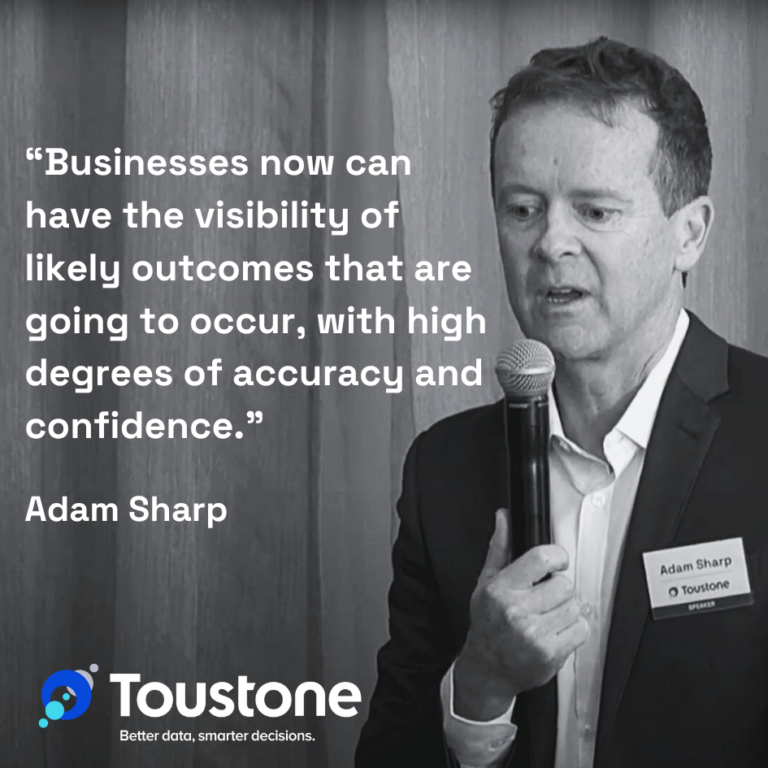
Some really good examples of that might be things like customer churn. So customer churn is all about identifying customers that are likely to leave a business. If we can identify those with high degrees of accuracy, we can then target our marketing spend to try and retain those customers. That speaks to things like efficiency of marketing spend and making sure that we can really target the areas of our business operations that we want to really focus on.
One perhaps for the train industry, is predictive maintenance around assets; identifying leading indicators when assets are going to break down to make sure we can perform maintenance. It’s all about taking data and really enhancing the use of that data to again enhance our decision making.
2. What can the rail industry take from your expertise? If this is a known railway or if this is an established railway you can take the data, but if it is a brand new railway, how would you support that with no data?
Adam: Well, yes indeed. So obviously until we have data, it’s very difficult to analyse it, but we are working with clients at the moment that are in the process of building our new operations and we are working with them on things like simulated data – we can generate dummy data or call it, that’s operationally typical and start to profile rational outcomes based on expected schedules.
“Nothing speaks to real data though, because when you get into the real world, the real scenarios on Earth themselves – they’re the ‘nuggets.'”
3. Can you tell us, what inspired your passion of applying statistical and data analysis techniques in practical business scenarios?
When you’re operating in a theoretical environment, everything works perfectly as you expect, but the real operational anomalies are those that can make or break successful operations. And those are the things that occur at the edges. The anomalies, the operational outliers and so on, that you really need to address and identify to minimise impacts.
Adam: It’s that question of, “why do you end up in life where you end up?” I’ve always been a bit of a maths and IT nerd at heart, but I started my career in general business, with a degree in economics and started for really the first 10 years of my career working in operational roles in general industry, finance, customer service and so on.
That gave me a really good understanding of how businesses operate and obviously the issues that they face. As I moved into the IT or the technical industry, after about 10 years or so, I moved eventually into the data space. That allowed me to start as I built my knowledge on data to reflect on, obviously my business knowledge and understanding and how to really leverage that experience on both sides to tie the two together. I’ve really been fortunate enough to work on numerous opportunities to build that knowledge and experience over time.
“I continue to be amazed frankly, as to how business operations and organisations can really benefit from well-done data and analytics, even more so over the recent 10 years technology has increased exponentially. There’s some pretty cool stuff going on nowadays and it’s fun.”
Rahiman: Especially as the data industry is a billion dollar industry now and every company is after the data because we are more keen on that nowadays. To move into the rail space, you have been bridging the gap between business and technology, and the data domains for decades now.
4. Could you share a memorable instance where this led to a particular innovative solution, especially on railways?
Adam: Well, to answer that question, the best example I can give you is we’ve been working with the organisation by the name of Metro Trains Sydney. So MTS is the organisation that’s contracted by the NSW government to operate the metro service currently in the North-West. So this is the driverless system running in the northwestern part of Sydney and currently being extended under the city out to the SW.
This is a privately operated entity, obviously funded by the government, and that funding then is dependent, or compensated fundamentally based on performance criteria.
Driving that obviously is a number of metrics such as examples delivered, service counts frequency and there’s a whole host of other quality scoring factors that go into it. Everything is geared towards ensuring that the service being provided is optimised from a customer experience perspective. So as you can appreciate all of these performance indicators are based on fundamental business processes, which in turn are managed by various systems, T systems/technology systems.
“It’s the data from those systems that that’s generated then becomes a very rich vein for analysis. We can expose all sorts of operational performance metrics and calculations based on that data source and that’s what we do.”
We now ingest a very large amount of data across a broad range of systems, in some cases overnight through to real time, and that’s all ingested into the Toustone platform. And once that data is ingested, we then process that into all of the necessary formats and structures, to then provide and give the organisation visibility of their operations against all of the various performance criteria.
The volume of that data is, as I said, very large and highly complex, as well as meeting against the complexity of the performance criteria as dictated by the government’s contracts. So that very complex regime of performance criteria has then been modelled into the engine, which then automatically generates the output on a daily basis.
“The result of all of that is a fully automated platform that ingests the data, reprocesses that data, generates all of the various reports, dashboards and all the rest of it. The business can then use this and analyse on a daily basis.”
The classic thing is it’s now seen as the single source of truth, so we don’t have manual calculations going on across the business with people arguing over the right number. They spend now time analysing and actioning the information as opposed to collating it and manually generating them. It also means accuracy is improved.
A memorable instance of where we’ve had a good outcome – this is a really good one! It’s been highly successful and we continue to evolve it into things like live data feeds. Now we’re looking at our operational activities down to, within the last couple of seconds – there’s a lot of opportunity to continue to evolve this.
5. How easy is this tool to use by the operator? Does Toustone provide any training or do we need Toustone’s continuous support for it?
Adam: It really depends on the client – in some cases this is generally across our client base. Some clients have their own technical team and we just come in for initial consulting and set up. Other clients don’t see it as part of their core business to maintain highly complicated technical environments, so we do offer that service for them. It really depends on that continuum as to where the client wants to sit.
In terms of technical setup, clearly that’s where our expertise is and that’s why we like to offer the service because we think it’s a very niche skill set and that’s what our expertise is – the user interface, if you like. We strive in all cases to make it as intuitive and simple to use as possible.
“In all cases, we provide analytics at the high level KPI and give our users the ability to drill down to the lowest level of detail, which gives them confidence in understanding how the result is derived through to auditability, accuracy, testing and so on. we take user experience and user simplicity as a very strong driver of our product and our service.”
6. Do you have any competitors in rail space?
Adam: From our perspective, we’re a data analytics company. We have very strong deep roots into the train and rail space by virtue of our clients that we are working with. I guess ultimately there are many data service providers out there.
I have countless examples though, where such competition has tried and not succeeded in where we have. So I’m not here to name names by any means, but certainly we pride ourselves on where we have succeeded where others have not. I’m not here to say we are the only people that can achieve these things, but we’re very proud and confident in our ability.
Rahiman: So big data has transformed industries – as you and I know, including railways.
7. Can you share an example of how you have helped a business leverage big data in ways they hadn’t previously considered, resulting in unexpected benefits?
Adam: The example I gave earlier was around electrical consumption data, so particularly in the rail space, electrical energy is a huge input, both in terms of cost and infrastructure. The example that I’ll share with Metro trains in Sydney is we are now in the process of ingesting (or we are now ingesting) a huge amount of electrical consumption data across many, many smart metres across their network. It’s down to the number of seconds of consumption breaking down by about 5 second increments and as you can appreciate, the volume of that data is quite colossal.
“What we’re now able to do are things like analysing usage patterns such as energy volume; where it’s being used when the peaks and the troughs are. We can break it down by locations to understand high energy areas, energy use areas etc.”
It’s been a significant achievement to automate all of that ingestion to enable the far, far more efficient ways of analysing the electoral consumption data. A very strong positive result of this is we’ve now got the data from which we can start to apply machine learning over that data. What this has enabled us to do is to also combine that with other external data influences.
This is so we can now understand operationally, relationships between various other factors across the operational landscape that impacts and influences energy consumption.
“So that then speaks to things like being able to adjust or potentially adjust operational parameters to impact energy consumption. This obviously is saving on money and emissions. By the way, emissions are a big thing nowadays!”
They are leading to highly accurate forecasts on energy consumption. In this case, we’re sort of about 6-12 months into the future with some very highly accurate forecasting information. That then leads us to the opportunities around the forward purchasing of energy and so on, which leads to very commercially favourable opportunities and so on.
As I briefly mentioned, with the whole increasing focus on ESG generally in industry, but specifically in rail – we can forecast likely carbon emissions based on future energy consumption.
“You can very accurately forecast for carbon emissions, and that allows you to start to look at things like supplementing renewables, where you may be over target or operationally looking at ways to adjust your operations to bring any future targets down to within the expected parameters and so on. “
There’s many other examples of where we’ve been able to leverage data like that with similar outcomes, but look, it’s probably the biggest thing that we’ve started to find now – and energy is a good example – where as we start to build up our catalogue of data sources, it allows us to do a lot more analysis across those silos of data. And we’re doing that sort of cross silo analysis that allows us to understand relationships between various systems and operational activities. That may not have previously been understood and thereby vastly improves the business decision making and opportunities that you can perform.
Rahiman: I think this is a really amazing tool and I believe the investors or the operators get back the money spent on this amazing tool.
You and your team at Toustone have been producing solutions that leverage artificial intelligence and mission learning for several years now. In fact, I hear Amazon approached your business to write a case study about the work in this area.
8. What is the difference between artificial intelligence and machine learning, and what have you worked on in rail that leverages this? What have been some of the benefits?
Adam: Well, thanks for raising that nomination from AWS for Amazon. We’re pretty proud of the recognition that Amazon has shown in us, it’s a great acknowledgement for the team generally, it’s not often that the might of an organisation like Amazon comes to focus on you. So we’re very, very proud of that indeed.
Your question is fantastic – what’s the difference between AI and ML, or artificial intelligence and machine learning? It’s actually often used interchangeably and incorrectly
“Simply put, machine learning is a subset of the overall artificial intelligence concept. So AI is the broader concept where technology mimics the way that humans think; artificial intelligence.”
It produces models that do things like understanding why things happen. What are the relationships? It’s explaining why things have occurred, to understand cause and effect analysis. The classic example that most people use ML for is forecasting.
So you’re generating forecasts of an outcome based on historical patterns and relationships, correlations and so on to provide highly accurate predictions of what’s going to occur in the future. What correlations between what you would expect to be unrelated events, but are in fact related becomes a significant insight.
That’s the classic basket analysis. So what products sell with what – that leads to things like co-location of products in a shop. You don’t realise it, but if you buy a jar of peanut butter and put a loaf of bread next to it, the probability of the two selling together is very high. They’re good examples of machine learning.
In terms of examples of where we’ve used it in the rail industry, I’ve already touched on the energy consumption space. That is a classic case for forecasting and prediction.
“We have done other work around asset wear; track wear and overhead wire wear as examples. It’s understanding and correlating or relating influences on that wear of the asset.”
So levels of acceleration, or weather or speed, or weight, and all sorts of other influences that potentially could describe, or at least explain the asset wear. That gives the organisation information on which can make decisions on how to minimise asset-wear if they adjust their operations accordingly.
Rahiman: Let’s talk about cross-cultural challenges as well – prior to founding Toustone, you led BI delivery for a global multinational. Your experience spans various countries in this Asia Pacific region.
9. Can you highlight cross-cultural challenges you have faced while implementing data and decision intelligence solutions, and how you overcame them?
Adam: As you mentioned, yes, I’ve worked across a number of years across my career, across a large number of nationalities. You say Asia Pacific, even through Europe and so on and through the US and it allows you to have appreciation for different ways of working culturally and how different people interact. We all bring different things to the table.
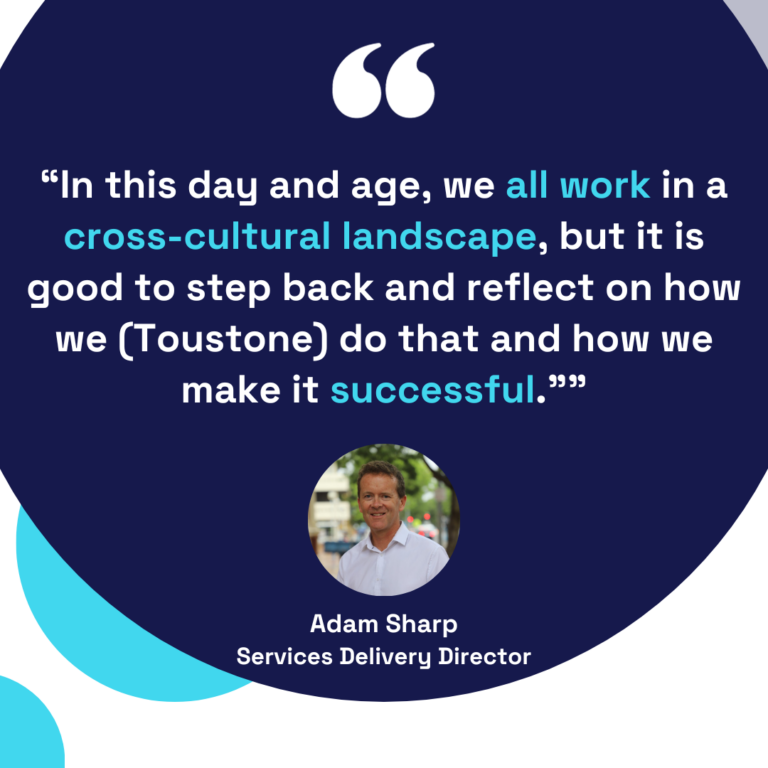
Probably the greatest challenge really is around different communication styles, and obviously, Australians and Americans tend to be very loud and overly confident, and other cultures tend to be very reserved and so on.
In many cases, English is the common language, which in a vast number of cases is a second language, sometimes not a language that people are confident to express their views in. It’s just making sure that as you are working across cultures that you are respectful of that and understanding of those differences and ensuring clear communication is set – both written and verbal, by the way.
So don’t flower words, don’t make things overly complicated, but also in continually checking in to make sure that we’re all on the same page or following along.
Other than communication, in my experience what I’ve also found is in terms of delivery of activity as well – it’s the actual delivery approach that can really assist in communicating what the results are, and agile approach is a classic way of doing that.
If we deliver incrementally small but regular insights, it gives people a very tangible insight into what it is we’re doing and how we’re working, “Is this what you want or not?” Did we misconstrue communication or misunderstand requirements? It can occur on both sides by the way. So by being able to deliver frequent and small incremental components, it allows us to steer very, very quickly if we’re getting slightly ‘off-track’ -to use a pun in the rail podcast!
It’s – in my experience – been a very useful approach to ensure that we remain on the right path in terms of requirements. It’s important to deliver that communication as I said at the right level to the audience and make sure that it’s an appropriate mix of business and technical speak. It’s about making sure that we all understand and can agree.
Rahiman: Going back into my intro about you helping the executives through helping them in decision making. I want to go back to that question about helping transport executives anticipate challenges and mitigate risk. That’s what your tool does, it is a crucial aspect of your work.
10. Can you walk us through an instance where you or your team’s foresight made a pivotal difference in project success?
Adam: Probably out of respect to our clients, I can’t speak to specific projects as such, but I can speak in general terms. I’m proud to say that as an organisation in our people, we bring our expertise and capabilities to our clients where as I said before other vendors frankly have failed.
We like to really create a collaborative partnership type of arrangement, and some of the philosophies that go along with that is that we aim to engage well with our clients and deliver successfully in using techniques like delivering small increments frequently in an agile way. As you can appreciate, the old days of running multi-year projects – well certainly in the technology sector at least – are very much over. We aim to deliver frequently, we evolve and move on.
So in terms of where we’ve had the foresight to make a difference in project successes that’s a key behavioural attribute that we like to promote.
“The other one too is having the confidence to respectfully challenge. We’re not about just doing as asked if we think there may be opportunities to improve or do it in a better way.”
Clearly that’s in a very respectful and engaging and collaborative mindset! Our clients are paying us to bring our expertise and capabilities, so if we think we can adjust the direction, we will do it.
To bring it down to the MTS and Metro trains example, we brought an extensive experience in analytics, data, technical design, architecture and so on.
“By working very closely with the MTS executives and business folks, we were able to iteratively evolve this platform it is today. It’s very much a collaborative way of working – a delivery focused approach to ensure that we are successful.”
Rahiman: Digital innovation is a hot topic in the rail industry. So that’s the whole point why I wanted you to be on this podcast – this is your bread and butter, of course.
11. What do you think the future of digital innovation, artificial intelligence and machine learning can look like for the rail industry. What is realistically possible?
Adam: We spent a lot of time kicking these ideas around and clearly we need to make sure that we’re future focused as well to ensure we continue to add value to our clients. There’s a number of areas that we think are very strong in terms of future possibilities. I don’t think the area of machine learning is anywhere near complete. There’s a huge opportunity for more of that sort of thing to automate and optimise decision making as much as possible.
“A good example might be incident response analysis to actionable information or actionable alerts and so on. In the event of incidents, leaders are usually flooded with all sorts of warnings and alerts. Being able to automate as much of that based on all sorts of inputs into the process is a great example of where those sorts of things can be optimised.”
Continuing to consolidate all the various data sets, the whole ‘big data world’ is an often used term now, but these data sets are not only internal to the organisation but there’s huge amounts of data externally as well. How they have impact on operational performance and operational outcomes can be starting to consolidate those and get insights into that.
A very deliberate example is increasing things like the use of predictive maintenance in assets. Really perfect operations should be the target. What is it that’s stopping us getting to that point? Can we forecast and predict things that are leading to anything less than perfect operations? That’s things like predictive maintenance which continue to improve operational monitoring, to understand key drivers of issues.
One area that we’re really sort of kicking around a bit at the moment, with a bit of fun, as much as anything is the space of what’s called the digital twin.
“The digital twin is a virtual representation of the world, and/or a digital representation of the world. We’re kicking that around where we have in real-time, rendering of the landscape. The station or a rail corridor – being able to render that in real time, allowing users to navigate through the space, to immerse the user in a virtual environment.”
That allows things like armchair rides, armchair analysis of what’s going on in the environment and then we can overlay all sorts of insights and data to supplement that landscape. It’s giving the user the ability to virtually explore, but also supplement a sort of understanding.
That leads to things like crew training with access to restricted areas without having to close corridors, tunnels and all sorts of things. Then it’s leveraging ML to start to visually present the insights based in this sort of 3D landscape. That is a bit of fun, but certainly from a digital perspective, starting to bring a number of different technologies together to really further enhance the understanding of business operations. There’s a lot of good stuff coming!
Rahiman: Thank you, Adam. I believe everyone listening to this podcast has got something to take away from today’s discussion.
You can listen to the full podcast on Spotify.
